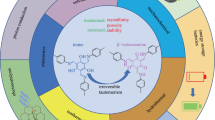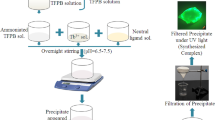Abstract
A novel fluorescein-bridged perylene bisimide (PBI) dimer for liquid crystal (LC) with geometrically symmetric structure was developed. The mesomorphic results indicated that the energetically stable and unstable conformers of fluorescein fragments could lead to the transformation of mesophases from a hexagonal columnar mesophase to an uncertain phase at 136.9 °C in heating, whilst a stable hexagonal columnar mesophase maintained between 175.6 °C and 58.6 °C in cooling. The selectively excited fluorescence characters in THF solution demonstrated that the fluorescence resonance energy transfer (FRET) effect between fluorescein fragments and PBI unites could provide a means to effectively impose strong fluorescence of the dimeric PBIs modified with suitable chromophore at the N-imide position, which alternatively serves as a platform for the further study of multi-functional PBI-based LCs.







Similar content being viewed by others
Data Availability
All the data and materials from this manuscript will be made available on request.
References
Zou D, Yang FF, Zhuang QX et al (2019) Perylene diimide-based electron-transporting material for perovskite solar cells with undoped poly(3-hexylthiophene) as hole-transporting material. Chemsuschem 12:1155–1161. https://doi.org/10.1002/cssc.201802421
Duan YW, Xu XP, Yan H et al (2017) Pronounced effects of a triazine core on photovoltaic performance-efficient organic solar cells enabled by a PDI trimer-based small molecular acceptor. Adv Mater 29:1605115. https://doi.org/10.1002/adma.201605115
Gupta RK, Dey A, Singh A et al (2019) Heteroatom bay-annulated perylene bisimides: New materials for organic field effect transistors. ACS Appl Electron Mater 1:1378–1386. https://doi.org/10.1021/acsaelm.9b00004
Matussek M, Filapek M, Gancarz P et al (2018) Synthesis and photophysical properties of new perylene bisimide derivatives for application as emitting materials in OLEDs. Dyes Pigments 159:590–599. https://doi.org/10.1016/j.dyepig.2018.07.006
Miao H, Yang J, Peng GL et al (2019) Enhancement of the degradation ability for organic pollutants via the synergistic effect of photoelectrocatalysis on a self-assembled perylene diimide (SA-PDI) thin film. Sci Bull 64:896–903. https://doi.org/10.1016/j.scib.2019.05.006
Zhu MG, Guo HY, Cai KC et al (2017) Novel fluorescence-enhancing effect based on light-induced E/Z isomerization of perylene diimides with Schiff-base groups on bay-positions. Dyes Pigments 140:179–186. https://doi.org/10.1016/j.dyepig.2017.01.048
Lü BZ, Chen YF, Li PY et al (2019) Stable radical anions generated from a porous perylenediimide metal-organic framework for boosting near-infrared photothermal conversion. Nat Commun 10:767. https://doi.org/10.1038/s41467-019-08434-4
Schulze M, Steffen A, Würthner F (2015) Near-IR phosphorescent ruthenium(II) and iridium(III) perylene bisimide metal complexes. Angew Chem Int Ed 54:1570–1573. https://doi.org/10.1002/anie.201410437
Wang Z, Wang G, Chang X et al (2019) A perylene bisimide-contained molecular dyad with high-efficient charge separation: Switchability, tunability, and applicability in moisture detection. Adv Funct Mater 29:1905295. https://doi.org/10.1002/adfm.201905295
You SS, Cai Q, Zheng Y et al (2014) Perylene-cored star-shaped polycations for fluorescent gene vectors and bioimaging. ACS Appl Mater Interfaces 6:16327–16334. https://doi.org/10.1021/am5045967
Sun PF, Yuan PC, Wang GN et al (2017) High density glycopolymers functionalized perylene diimide nanoparticles for tumor-targeted photoacoustic imaging and enhanced photothermal therapy. Biomacromol 18:3375–3386. https://doi.org/10.1021/acs.biomac.7b01029
Song Y, Zhang W, He S et al (2019) Perylene diimide and luminol as potential-resolved electrochemiluminescence nanoprobes for dual targets immunoassay at low potential. ACS Appl Mater Interfaces 11:33676–33683. https://doi.org/10.1021/acsami.9b11416
Sethy R, Kumar J, Métivier R et al (2017) Enantioselective light harvesting with perylenediimide guests on self-assembled chiral naphthalenediimide nanofibers. Angew Chem Int Ed 56:15053–15057. https://doi.org/10.1002/anie.201707160
Spenst P, Würthner F (2015) A perylene bisimide cyclophane as a “turn-on” and “turn-off” fluorescence probe. Angew Chem Int Ed 127:10303–10306. https://doi.org/10.1002/ange.201503542
Würthner F, Bauer C, Stepanenko V et al (2008) A black perylene bisimide super gelator with an unexpected J-type absorption band. Adv Mater 20:1695–1698. https://doi.org/10.1002/adma.200702935
Würthner F, Thalacker C, Diele S et al (2001) Fluorescent J-type aggregates and thermotropic columnar mesophases of perylene bisimide dyes. Chem Eur J 7:2245–2253. https://doi.org/10.1002/1521-3765(20010518)7:10%3c2245::AID-CHEM2245%3e3.0.CO;2-W
Eccher J, Zajaczkowski W, Faria GC et al (2015) Thermal evaporation versus spin-coating: Electrical performance in columnar liquid crystal OLEDs. ACS Appl Mater Interfaces 7:16374–16381. https://doi.org/10.1021/acsami.5b03496
Gupta RK, Sudhakar AA (2019) Perylene-based liquid crystals as materials for organic electronics applications. Langmuir 35:2455–2479. https://doi.org/10.1021/acs.langmuir.8b01081
Funahashi M (2014) Nanostructured liquid-crystalline semiconductors – a new approach to soft matter electronics. J Mater Chem C 2:7451–7459. https://doi.org/10.1039/C4TC00906A
Kong X, Gong H, Liu P et al (2018) Synthesis and investigation on optoelectronic properties of mesogenic triphenylene–perylene dyads linked by ethynylphenyl bridges. New J Chem 42:3211–3221. https://doi.org/10.1039/C7NJ04328G
Guo HY, Zhu MG, Wang ZS et al (2016) Triphenylene–perylene–triphenylene triads with bay-substituents: synthesis, mesomorphism, and electron transfer properties. Tetrahedron Lett 57:4191–4195. https://doi.org/10.1016/j.tetlet.2016.08.004
Xiao Y, Su X, Sosa-Vargas L et al (2016) Chemical engineering of donor–acceptor liquid crystalline dyads and triads for the controlled nanostructuration of organic semiconductors. CrystEngComm 18:4787–4798. https://doi.org/10.1039/C6CE00365F
Lee KJ, Woo JH, Xiao YM et al (2016) Structure-charge transfer property relationship in self-assembled discotic liquid-crystalline donor–acceptor dyad and triad thin films. RSC Adv 6:57811–57819. https://doi.org/10.1039/C6RA08039A
Zhao KQ, An LL, Zhang XB et al (2015) Highly segregated lamellocolumnar mesophase organizations and fast charge carrier mobility in new discotic donor–acceptor triads. Chem Eur J 21:10379–10390. https://doi.org/10.1002/chem.201500889
Zhu MG, Guo HY, Yang FF et al (2016) Novel room-temperature perylene liquid crystals: synthesis of 1,7-dibrominated cholesterol–perylene bisimides with different ester-bridging chains and their mesomorphic properties. Liq Cryst 43:1875–1883. https://doi.org/10.1080/02678292.2016.1218073
Zhu MG, Guo HY, Yang FF et al (2017) Synthesis, mesomorphic and photophysical properties of novel triads and pentads of perylene liquid crystals with cholesterol units at the bay-position. RSC Adv 7:4320–4328. https://doi.org/10.1039/C6RA27003D
Zhang TJ, Sun DM, Ren XK et al (2013) Synthesis and properties of siloxane modified perylene bisimide discotic liquid crystals. Soft Matter 9:10739–10745. https://doi.org/10.1039/C3SM52054D
Gao BX, Xia DF, Zhang LC et al (2011) Helical columnar liquid crystals based on dendritic peptides substituted perylene bisimides. J Mater Chem 21:15975–15980. https://doi.org/10.1039/C1JM13144C
Funahashi M, Yamaoka M, Takenami K et al (2013) Liquid-crystalline perylene tetracarboxylic bisimide derivatives bearing cyclotetrasiloxane moieties. J Mater Chem C 1:7872–7878. https://doi.org/10.1039/C3TC31567C
Zeng Y, Lu L, Gao T et al (2018) Synthesis, helical columnar liquid crystalline structure, and charge transporting property of perylene diimide derivative bearing oligosiloxane chains. Dyes Pigments 152:139–145. https://doi.org/10.1016/j.dyepig.2018.01.048
Ben HJ, Ren XK, Song B et al (2017) Synthesis, crystal structure, enhanced photoluminescence properties and fluoride detection ability of S-heterocyclic annulated perylene diimide-polyhedral oligosilsesquioxane dye. J Mater Chem C 5:2566–2576. https://doi.org/10.1039/C6TC05171E
Hecht M, Schlossarek T, Stolte M et al (2019) Photoconductive core-shell liquid-crystals of a perylene bisimide J-aggregate donor-acceptor dyad. Angew Chem Int Ed 58:12979–12983. https://doi.org/10.1002/anie.201904789
Meng L, Wu QM, Yang FF et al (2015) Novel room-temperature thermotropic liquid crystals: Synthesis and mesomorphism of gallic-perylene-gallic trimers. New J Chem 39:72–76. https://doi.org/10.1039/C4NJ00993B
Zhu MG, Chen YZ, Guo HY et al (2018) Perylene liquid crystals with multiple alkyl chains: investigation of the influence of peripheral alkyl chain number on mesomorphic and photophysical properties. New J Chem 42:8998–9005. https://doi.org/10.1039/C8NJ00480C
Zhu MG, Guo HY, Yang FF et al (2016) Novel perylene liquid crystals: Investigation of the influence of bay-substituents on mesomorphism and photophysical property. Dyes Pigments 133:387–394. https://doi.org/10.1016/j.dyepig.2016.06.021
Zhu MG, Zhuo YZ, Cai KC et al (2017) Novel fluorescent perylene liquid crystal with diphenylacrylonitrile groups: Observation of a large pseudo stokes shift based on AIE and FRET effects. Dyes Pigments 147:343–349. https://doi.org/10.1016/j.dyepig.2017.08.027
Zhu MG, Zhuo YZ, Guo HY et al (2018) Enhanced fluorescence in both solution and solid state for perylene liquid crystals with six peripheral alkyl substituents on 1,6,7,12-bay positions and imides positions. J Lumin 194:264–270. https://doi.org/10.1016/j.jlumin.2017.10.049
Zhu MG, Chen YX, Zhang XY et al (2018) Perylene bisimide with diphenylacrylonitrile on side-chain: strongly fluorescent liquid crystal with large pseudo Stokes shift based on AIE and FRET effect. Soft Matter 14:6737–6744. https://doi.org/10.1039/C8SM01183D
Hippius C, van Stokkum IHM, Zangrando E et al (2008) Ground- and excited-state pinched cone equilibria in calix [4]arenes bearing two perylene bisimide dyes. J Phys Chem C 112:14626–14638. https://doi.org/10.1021/jp804068b
Qu JF, Mu Z, Lai HJ et al (2018) Effect of the molecular configuration of perylene diimide acceptors on charge transfer and device performance. ACS Appl Energy Mater 1:833–840. https://doi.org/10.1021/acsaem.7b00277
Petrella A, Cremer J, Cola LD et al (2005) Charge transfer processes in conjugated triarylamine-oligothiophene-perylenemonoimide dendrimers. J Phys Chem A 109:11687–11695. https://doi.org/10.1021/jp0510995
Prajitha KP, Asha SK (2016) The synthesis and structural characterization of twin liquid crystalline perylenebisimides. New J Chem 40:8471–8478. https://doi.org/10.1039/C6NJ00524A
Kobayashi T, Urano Y, Kamiya M et al (2007) Highly activatable and rapidly releasable caged fluorescein derivatives. J Am Chem Soc 129:6696–6697. https://doi.org/10.1021/ja070376d
Fan T, Shi R, Tang H, Guo H et al (2020) First fluorescein liquid crystals: synthesis, mesomorphic and fluorescence properties of fluorescein-triphenylene dimers. Liq Cryst 47:1762–1771. https://doi.org/10.1080/02678292.2020.1725986
Guo HY, Lin LB, Qiu JB et al (2017) Phenylacrylonitrile-bridging triphenylene dimers: The columnar liquid crystals with high fluorescence in both solid state and solution. RSC Adv 7:53316–53321. https://doi.org/10.1039/C7RA10218F
Fang XT, Guo HY, Yang FF et al (2017) Near-infrared fluorescent and columnar liquid crystal: synthesis, and photophysical and mesomorphic properties of triphenylene-Bodipy-triphenylene triad. RSC Adv 7:23657–23662. https://doi.org/10.1039/C7RA00982H
Acknowledgements
We are grateful for the National Natural Science Foundation of China (No: 21406036), Fujian Science, Technology Project (No. 2019N0010) and the Key Research Program in Neijiang Normal University (2020).
Funding
The study was supported by the National Natural Science Foundation of China (No: 21406036), Fujian Science, Technology Project (No. 2019N0010) and the Key Research Program in Neijiang Normal University (2020).
Author information
Authors and Affiliations
Contributions
M. Z.: experiments and data treatment; M. C.: synthesis of the target compound; H. G.: some measurements of fluorescence and mesomorphic properties; F. Y.: study design and writing of the manuscript.
Corresponding authors
Ethics declarations
Competing Interests
No potential conflict of interest was reported by the authors.
Additional information
Publisher's Note
Springer Nature remains neutral with regard to jurisdictional claims in published maps and institutional affiliations.
Supplementary Information
Below is the link to the electronic supplementary material.
Rights and permissions
About this article
Cite this article
Zhu, M., Chen, M., Guo, H. et al. Fluorescein-bridged Perylene Bisimide Dimer for Use as Liquid Crystal: Studies on Mesomorphic and Fluorescence Properties. J Fluoresc 31, 1555–1565 (2021). https://doi.org/10.1007/s10895-021-02793-2
Received:
Accepted:
Published:
Issue Date:
DOI: https://doi.org/10.1007/s10895-021-02793-2




